
“I have completed over 50 research projects independently as Principal Investigator with national and state level governments, developmental organisations (World Health Organisation, International Union against TB and Lung Diseases, Global Health Advocacy Incubator etc.), NGOs (Generation Saviour Association, SNEHA, SIPHER) on diverse public health topics specifically tobacco control and NCDs”
| S. No. | Name of Project | Sponsoring Agency | Highlight of the project |
|---|---|---|---|
| 1 | Advancing Tobacco control at National and Sub-National level through capacity building, MPOWER implementation and support to National Tobacco Control Programme (NTCP) (Phase-II) | International Union Against TB and Lung Diseases (The Union) | Successful establishment of a dedicated committee to implement Article 5.3 of the WHO FCTC in Puducherry and Meghalaya. This initiative facilitated institutional mechanisms for tobacco control, including signage installations, training sessions, and the formation of SLCC and DLCC across 11 out of 14 intervention districts. Additionally, 18 physical workshops and 40 webinars were conducted, resulting in vital policy formulations and over 329 one-on-one meetings with high-level officials. Moreover, 20 state and district-level circulars were issued to strengthen enforcement of the NTCP and COTPA. The E-RCTC Portal was updated with 1300+ circulars, 40+ publications, and 100+ IEC materials, garnering global viewership. The comprehensive efforts recognized by the WHO Regional Director's Special Recognition Award in 2022 |
| 2 | Conducting an umbrella review on impact of Electronic Nicotine Delivery system (ENDS) on health and its efficacy and safety on tobacco cessation | World Health Organization | The umbrella review on electronic nicotine delivery systems (ENDS) assessed their safety, efficacy, and health impacts by synthesizing evidence from multiple systematic reviews and meta-analyses. Examined a broad spectrum of studies, it evaluated the diverse range of ENDS products, including e-cigarettes and vape pens, to elucidate their effects on users. The review scrutinized potential adverse health outcomes, such as respiratory issues, cardiovascular diseases, and addiction, alongside exploring ENDS' role in smoking cessation. By consolidating findings from various sources, this comprehensive analysis aimed to provide policymakers, healthcare professionals, and the public with an informed perspective on ENDS utilization and its implications for public health. |
| 3 | Evaluation of National Tobacco Quitline Services | World Health Organization | The study employed a mixed methods approach to assess the effectiveness of NTQLS. This involved a retrospective analysis of NTQLS data spanning from July 2016 to December 2022, alongside qualitative and quantitative analyses of both users’ and service providers’ perspectives. Meetings were arranged with directors from WHO and NTQLS at four different locations. Study tools were devised, and data collection commenced, incorporating a total of four Focus Group Discussions (FGDs), nineteen In-Depth Interviews (IDIs), and completion of 320 surveys. The results of the evaluation unveiled high levels of caller satisfaction with the counseling services provided by NTQLS counselors. Additionally, callers expressed gratitude towards the efforts made by the Government of India in this regard. |
| 4 | StrengtheningManagement of Hypertension Services through capacity Building, Media and Communication, and StakeholdersEngagement in the State of Punjab.(Phase II) | Global Health Advocacy Incubator. | The overall purpose of phase-1 of the project is to strengthen politico- institutional framework of Indian Hypertension Management Initiative (IHCI) in the State of Punjab through capacity building, media and communication, and stakeholders engagement |
| 5 | Advancing Tobacco control at National and Sub-National level through capacity building, MPOWER implementation and support to National Tobacco Control Programme (NTCP). (Project I.D. 2055) (Phase II) | International UnionAgainst TB and Lung Diseases(The Union). | The objective of the study is to strengthen the policy and institutional framework of National tobaccocontrol program in states of Odisha, Telangana, Meghalaya and Puducherry in India through capacity building, MPOWER policy implementation and enactment of FCTC Article 5.3 policy in these four states. The work accomplished tilldate are: baseline assessment of institutional mechanism of tobacco control, MPOWER and COTPAstatus of project states, developmentof a virtual resource centre (www.rctc.org) for tobacco control and networking with stakeholders in focusedstatesforstrengtheningTC program. |
| 6 | Intervention on Behavior of Tobacco Usersattending Non CommunicableClinicsof Punjab.(PhaseII) | StateTobacco ControlCell, Dept. of Health and Family Welfare, Punjab | The study aims to assess the behavioral approaches for tobacco cessationinnon-communicable diseaseclinics.Inthestudybooklet willbedevelopedtoequipandenhanced the knowledge and skills of health professionals working in NCD clinicsandforpatientsinformation material, text messages, motivational videoswillbeprovidedtoimprove the cessation rate and to improve the qualityoflifewithbetterhealth outcomeofpatients,contributingin achievingtheSDGs |
| 7 | Efficacy of behavioral change intervention package for tobacco cessation in tertiary healthcare setting- Randomized Controlled Trial. (Phase II) | PGIMER Research scheme | The study aims to undertakeformative and summative research on cost effective intervention addressing tobacco use in tertiary healthcare settings. Based on the social learning theory behavioral change packagewill be used to address the change in tobacco use status. Primary outcome of the study will be to biochemically verify continuous tobacco abstinence at 12 months |
| 8 | Strengthening Management of Hypertension Services through capacity Building, Media and Communication, and Stakeholders Engagement in the State of Punjab (Phase-I) | Global Health Advocacy Incubator | Mapping and engaging of elected representatives and bureaucratic ranks at district and state level was done to place hypertension on a priority list of the state government. We liasoned with over 15 reputed media houses which resulted in the publication of 96 news articles (print and digital media). 'Hub and Spokes' model was followed to promote the telemedicine services at HWC. State government which has been highlighted in a global seminar as 'Lessons from political victories- case study of Punjab, India'. Further state government has nominated 'Transfat free Diwali Campaign' launched under the project under 'Best Practices' for Skoch Award. We also launched a 'Resource centre for Cardiovascular Health' ‘www.rccvh.org’, bimonthly theme-based newsletter 'Cardio- Health' (n=4 editions) and seven policy focused manuscripts. |
| 9 | Advancing Tobacco control at National and Sub-National level through capacity building, MPOWER implementation and support to National Tobacco Control Programme (NTCP) (Phase-I) | International Union Against TB and Lung Diseases (The Union) | Baseline assessment of institutional mechanism of tobacco control, MPOWER and COTPA status of project states was done, a web-based portal “E-Resource Centre for Tobacco Control” (www.rctc.org) for tobacco control was developed and also networking with stakeholders in focused states for strengthening TC program was done. Published bi- monthly theme based newsletter “Tobacco free Times”. Various webinars and seminars were conducted for wider distribution of Tobacco control across country. |
| 10 | Strengthening Enforcement of Taps ban with focus on point of sale through Tobacco Vendor Licensing in two cities of India. | John Hopkins University, Baltimore | 559 tobacco vendors were mapped in Ranchi and 367 in Siliguri. Tobacco vendor density was 68 vendors/km2, 6 vendors/km, and 8 vendors/1000 population in Ranchi. While in Siliguri, the tobacco vendor density was 99 vendors/km2, 5 vendors/km and 7 vendors/1000 population. 19% were (n=105) vendors observed in Ranchi and 23% (n=84) of vendors in Siliguri were located within 100-yards of one or more schools. The most common vendor-type in Ranchi was an independent store (58%) and that in Siliguri was a permanent kiosk (52%). |
| 11 | Intervention on Behavior of Tobacco Users attending Non Communicable Clinics of Punjab (Phase-I) | State Tobacco Control Cell, Dept. of Health and Family Welfare, Punjab | To assess the behavioral approaches for tobacco cessation booklet was developed to equip and enhanced the knowledge and skills of health professionals working in NCD clinics and for patients information material, text messages, motivational videos was provided to improve the cessation rate |
| 12 | Efficacy of behavioral change intervention packagefortobacco cessationintertiary care Hospital | PGIMER Research scheme | Based on the social learning theory behavioral change package has been prepared and validated after consulting experts in the field of tobacco control. |
| 13 | Assessment compliance to “Smoke free legislation” in eight districts of Haryana and UT Chandigarh | Generation Savior Association (GSA) The Union – International Union Against Tuberculosis and Lung Disease | The mean compliance to major indicators of Section 4, 5, 6 (a), 6 (b), 7, 8 and 9 of COTPA was 80.6%, 93.7%, 68.5%, 63.4%, 99.1% in Haryana and 82.8%, 98.5%, 56.0%, 77% and 99.6% in Chandigarh. The overall compliance to all Sections of COTPA (based upon mean of major compliance indicators) was 83.5% in Haryana and 82.8% in Chandigarh. |
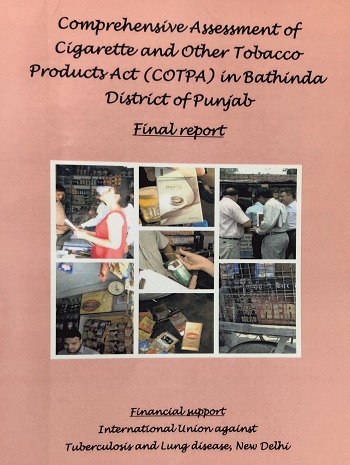
An overall compliance to Section 4 of COTPA in Bathinda district was 88.3%. No active smoking, no cigarette and no bidi buts and no smoking aids were found at 98.6%, 87.5% and 94.1% of the public places respectively. At 91.3% of public places, no advertisement of tobacco products at POS was observed. The compliance to selling of loose cigarette was 66.3% and compliance to Section 6(a) of COTPA was 41.4%.
(Funding Agency: International Union against Tuberculosis and Lung Diseases)

Nearly two-third of population were aware about tobacco ban in the state and majority (90%) supported the on-going ban on the tobacco products. 98.3% smokers found no difficulty in buying loose cigarettes from point of sale and merely 0.7% users felt that ban helped them quit smoking.
(Funding Agency: State Health Society, Tobacco Control Cell Punjab and MANT, Kolkata)

Majority of vendors were compliant to ban on painting kiosks with tobacco advertisements and very less number of vendors were found selling tobacco products to the minors. Minimal numbers of vendors were found selling E-cigarette and a high percentage of vendors felt that the ban was giving a positive response.
(Funding Agency: State Health Society, Tobacco Control Cell Punjab and MANT, Kolkata)

An Integrated Health Program Package (IHPP) was developed under the project based upon their training needs which consists of a comprehensive module for health workers on major national health programs along with 12 video films on national programs. This pre-post interventional study found a statistical increase in knowledge and skills of health workers on various national health programs after implementation of package.
(Funding Agency : PGIMER Research Scheme)

The research conducted has identified the major factors that have led to the acute shortage of medical professionals in India. It highlights the motivational factors that underpin medical students’ selection of medical studies and also the encouraging and discouraging factors affecting the interest of medical students and medical doctors in working in rural areas from 4 major North Indian states.
(Funding Agency: Indian Council of Medical Research, New Delhi)
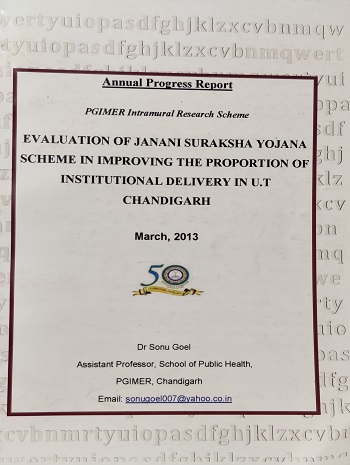
High knowledge about JSY amongst beneficiaries and health care providers was found, however, only one third (38.6%) had uptake of JSY services. The main reasons reported for choosing delivery under JSY were faith on service providers, while receipt of a meagre amount, delay in disbursement and poor accessibility were the barriers.
(Funding Agency: PGIMER Research Scheme)

The major activities performed under the project were constitution of a health promotion committee at institute and a health promotion cell comprising of senior functionaries. Besides, survey of employees, training programmes on HPH, workshops on BMWMs and seminar on Information, Education and Communication (IEC) on HPH and subsequent display of material were done.
(Funding Agency: World Health Organization, SEARO)

One-fifth vendors displayed appropriate signage’s at Point-of-Sale, where-as Section 6 (b) stating ‘prohibition on sale in radius of 100 yards’ was displayed at 59% of educational institutions, more in urban as compared to rural area. The vendors were selling tobacco products (around 1/4th) within 100 yards of institute’s boundary. There was no visible sale of tobacco products in the campus.
(Funding Agency: International Union against Tuberculosis and Lung Diseases)

Violation to Section 5 of COTPA was observed in nearly half of the surveyed Point of Sale (POS). Violation was comparatively less for promotional advertisement parameters (22.8%) and more for health warning parameters (82.2%). Violation was more in rural area, permanent shops and shops, which did not have tobacco as major business as compared to urban, temporary kiosks and other shops respectively.
(Funding Agency: International Union against Tuberculosis and Lung Diseases)

Overall 243 rodents and 57 fleas from HP and 20 rodents and 85 fleas from Surat were collected. Sylvatic cycle was elucidated. The results shows intermixing in rat and flea species between wild and domestic areas. Further, the relationship of certain climatic variables and soil with plagues was established.
(Funding Agency : Indian Council of Medical Research, New Delhi)

Awareness about this Nischay scheme amongst beneficiaries of district Panchkula was low, but high in Hisar. All the beneficiaries who were aware of the scheme had utilized Nischay kit and even advised their peers to use. There was no significant change in ANC parameters after launch of Nischay Scheme in both districts.
(Funding Agency: Indian Council of Medical Research, New Delhi)

A self-instructional training manual on epilepsy was developed and published in Hindi ‘Mirgi ke bare main samanye tathye’ and English ‘Epilepsy and its Management’ language. The end line knowledge and skills assessment was done after 2 months of administration of package, which resulted in statistical increase in their knowledge and skills.
(Funding Agency: PGIMER Research Scheme)
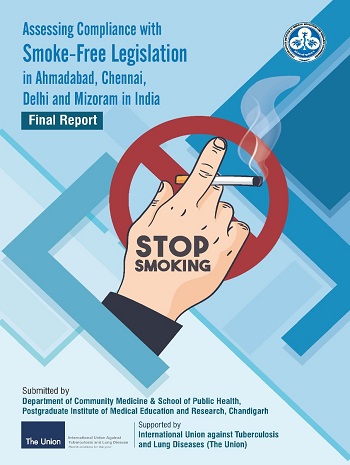
The overall compliance of Patiala, Ferozepur, Faridkot, Fazilka and Jalandhar districts are 85.2%, 89.5%, 96.9%. 88.9% and 87.6% respectively. Moreover, active smoking was not found in over 98% public places in all the districts.
(Funding Agency: Tobacco Control Cell, Punjab)
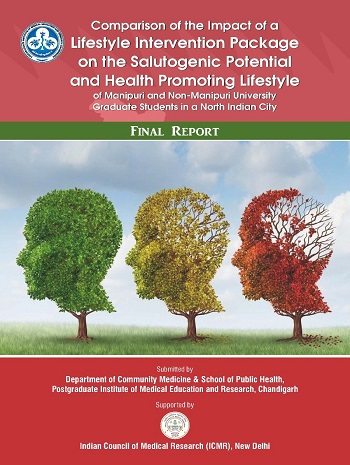
In a two group RCT conducted amongst students, Group A (received training on lifestyle intervention package viz. physical exercise, dietary assessment and modification, yoga, spiritual orientation, philanthropy work PLUS manual) fared better in terms of BMI, waist circumference, dietary habits, physical activity and SOC score than group B students (received only manual).
(Funding Agency: Indian Council of Medical Research, New Delhi)
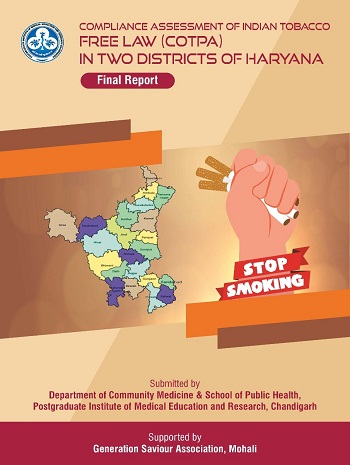
The overall compliance to COTPA was 53.3% and both districts were 50% compliant with respect to mean of major compliance indicators for all sections. The poor compliance (28.5%) were observed for section -5 whereas good compliance were observed for section 7,8,9 (71.7%) and section 4 (65.7%). Ambala was more compliant to all sections than Kurukshetra (except section 7, 8& 9).
(Funding agency: Generation Savior Association)
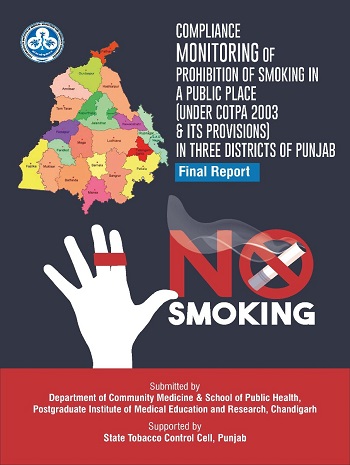
The overall compliance of Nawanshahr, Bathinda and Gurdaspur districts are 87.9, 74.5 and 88.5% respectively. However, active smoking was not found in over 95% public places in all the districts.
(Funding Agency: Tobacco Control Cell, Punjab)
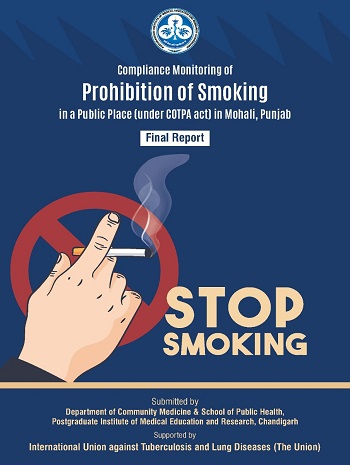
The study concluded that overall compliance rate in all the selected public places of Community Development Blocks of Mohali was between 88-100%.
(Funding Agency: International Union against Tuberculosis and Lung Diseases)
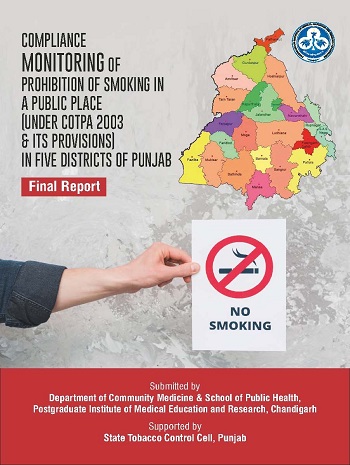
The overall compliance of Patiala, Ferozepur, Faridkot, Fazilka and Jalandhar districts are 85.2%, 89.5%, 96.9%. 88.9% and 87.6% respectively. Moreover, active smoking was not found in over 98% public places in all the districts.
(Funding Agency: Tobacco Control Cell, Punjab)
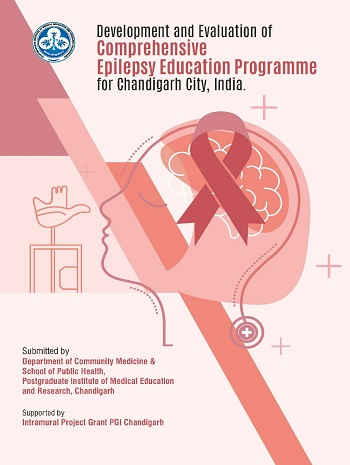
Knowledge about epilepsy was quite poor among the students of Chandigarh. The level of knowledge was almost similar among slums, urban and rural areas. An epilepsy educational programme for school children of Chandigarh was developed and distributed to selected schools of city.
(Funding Agency: NRHM, U.T Chandigarh)
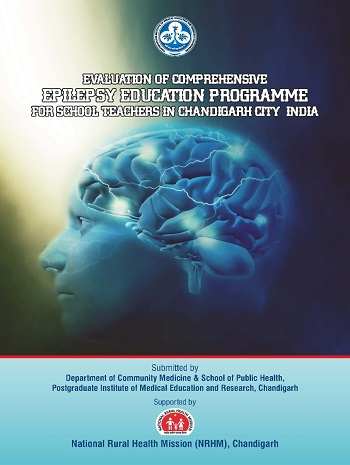
A booklet (in Hindi and English language) for school teachers and students was published and distributed. The skill based training of students and teachers of all (n=104) schools across Chandigarh was imparted. There was statistically significant effect of intervention on their knowledge and skills. The cascading effect in form of skits, lectures, plays across different schools in Chandigarh on epilepsy was observed.
(Funding Agency: PGIMER Research Scheme)
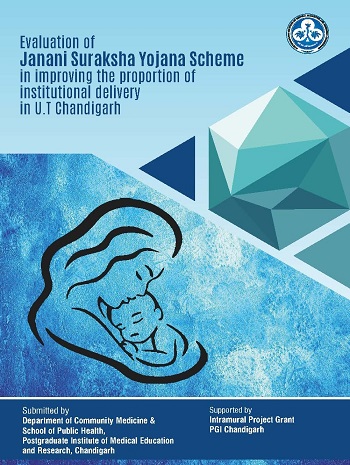
High level of knowledge about JSY program amongst the beneficiaries and basic health care providers was found, however, only one third (38.6%) of beneficiaries had uptake of JSY services.
(Funding Agency: PGIMER Research Scheme)
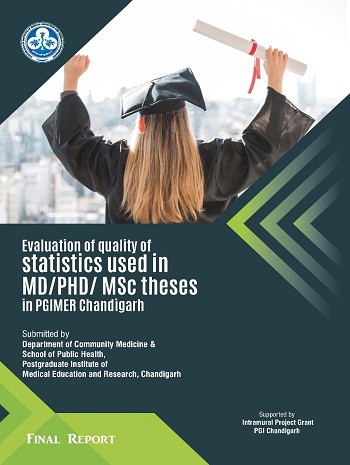
(Funding Agency : PGIMER Research Scheme)
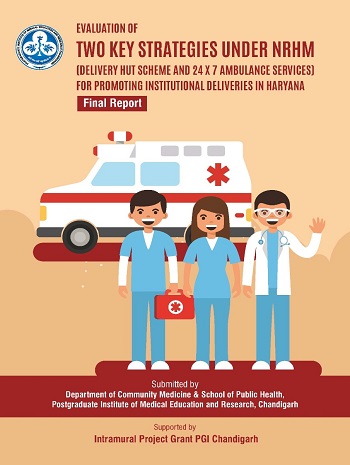
Around 80% of respondents were aware while 70% were able to access delivery hut scheme. One third choose this service as it was easily accessible while 70% stated delivery hut services were available even in the odd hours of night. Around half (47.5%) reported ambulance condition was good, however, only 20% were happy about the behavior of ambulance staff.
(Funding Agency: PGIMER Research Scheme)
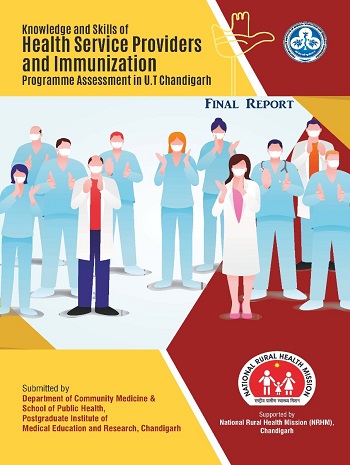
Median knowledge scores of medical officers and health workers were around 60%. Median skill score of health workers was higher (88%) than the medical officers (60%).
(Funding Agency: NRHM, U.T Chandigarh)
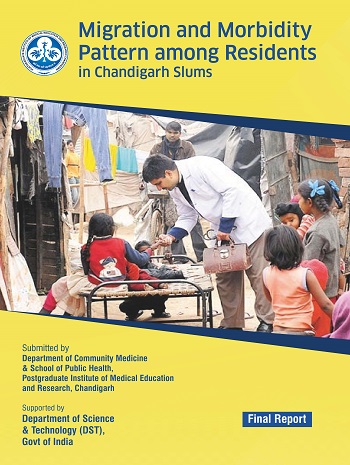
Most migrants (90%) in slums of Chandigarh belonged to Bihar and Uttar Pradesh. 48.5% households have no access to any toilet facility, 8% children (12-23 mths) un-immunised. Fever (25.8%), abdominal pain (12.9%), cough (17.6 %) and diahorrea (6.5%) were most common acute morbidities while hypertension (15.2%), abdominal pain (10.7%) were common chronic morbidities.
(Funding Agency : Department of Science and Technology, U.T Chandigarh)
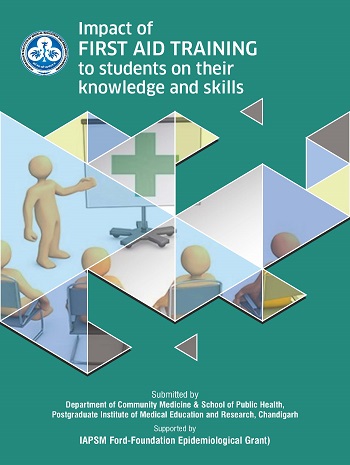
A training manual on 40 common childhood illnesses ‘Swasthya Chalisa’ was prepared. There was a statistically significant increase in level of knowledge (33%) and skills (135%) in Group B (manual plus on-the-spot demonstration training sessions) than Group-A (manual only).
(Funding Agency : IAPSM Ford-Foundation Epidemiological Grant)
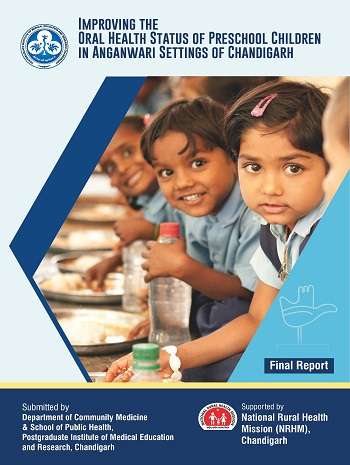
Prevalence of caries in children aged 3-6 years in anganwaris of Chandigarh was 48.3%. Overall knowledge score of AWWs in both the projects increased significantly post- intervention, however, the increase in skills was significantly more pronounced in skill based package. Caries susceptibility (by Snyder test) among children decreased from 48.2% pre-intervention to 31.2% post- intervention.
(Funding Agency: NRHM, U.T Chandigarh)
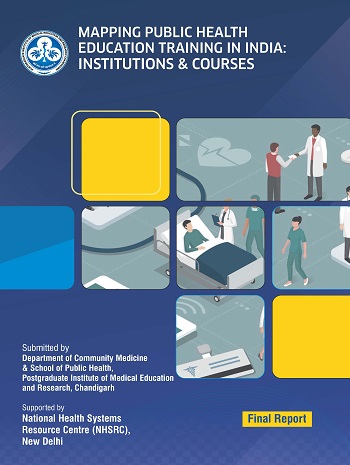
The study undertook mapping of public health education training in by internet search followed by personal interview of head of institution/ related course faculty. All the courses were affiliated with some university. The courses ranged from MD Community Medicine, Masters in Public Health, Masters in Hospital Administration, Msc Statistics, Msc nursing, M Phil, PHD Sociology etc.
(Funding Agency : National Health System Resource Centre, New Delhi)
